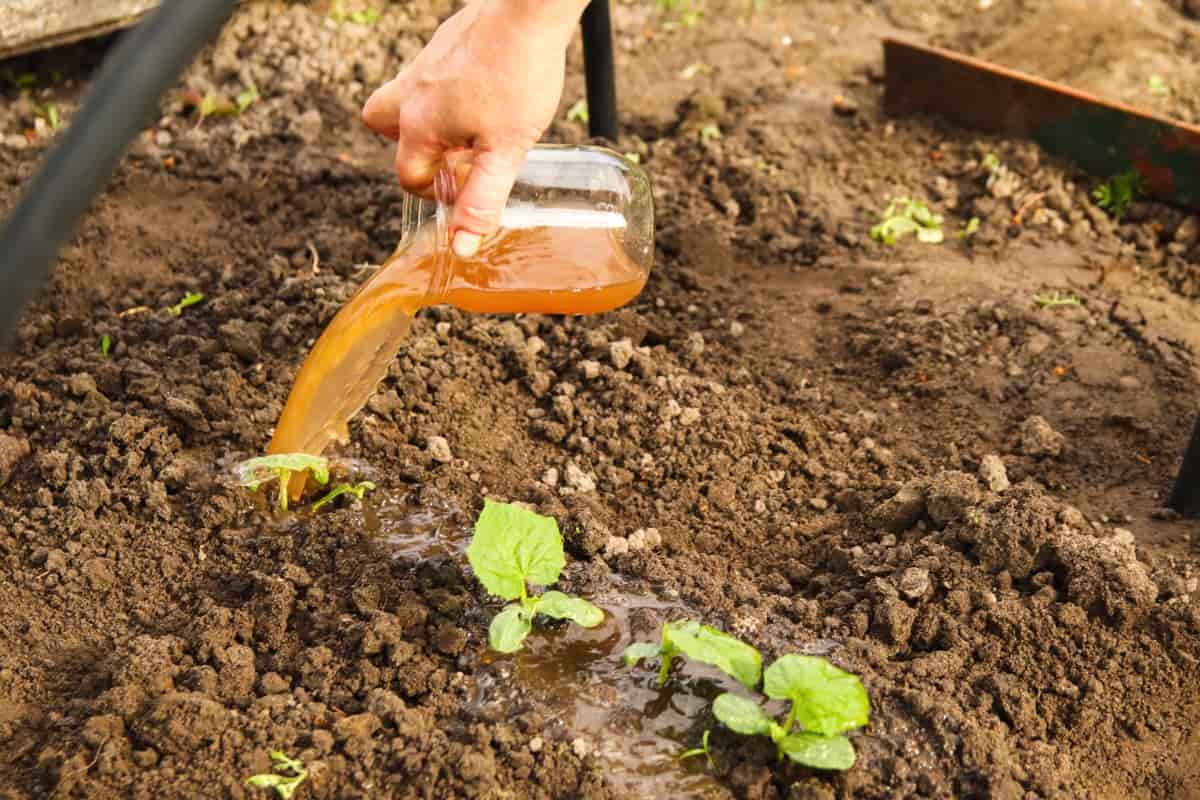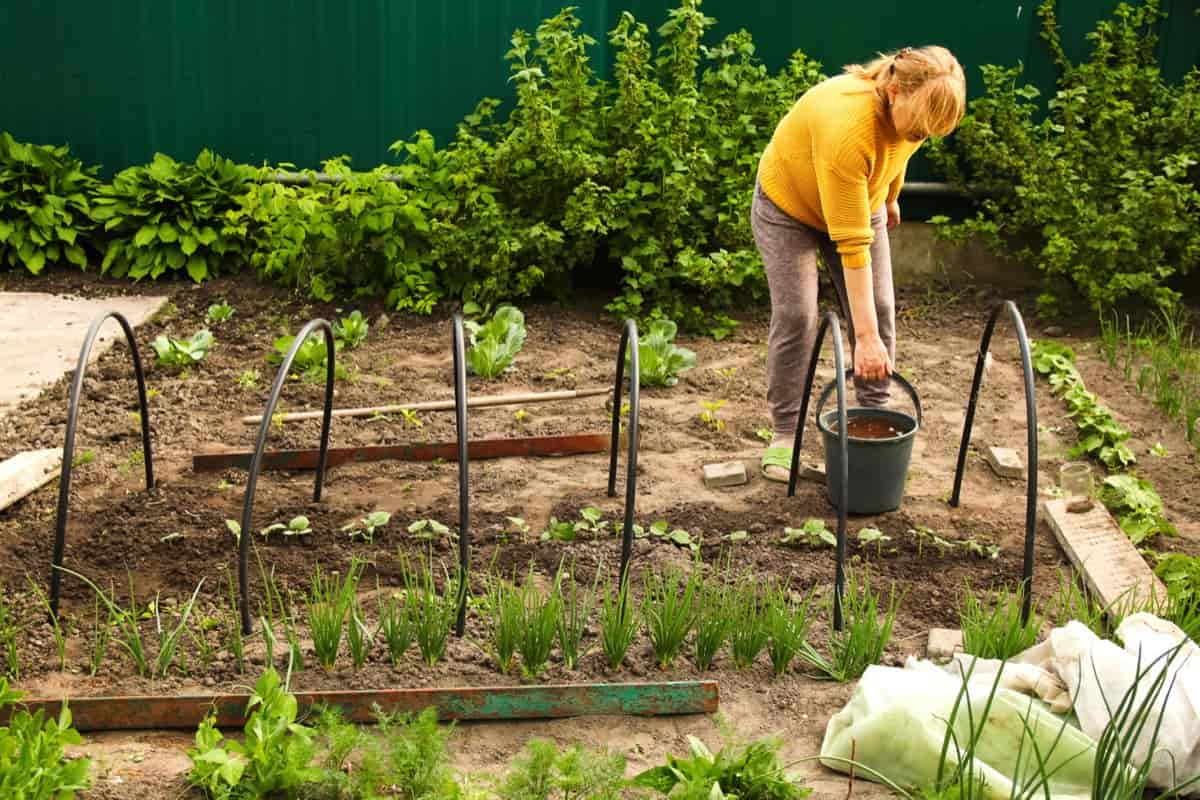The Comfrey plant is a hardy perennial plant that grows quickly; the plant needs no special care and grows in partial shade of the sun. Comfrey is a tall, perennial herb plant. It is a member of the Boraginaceae family. Furthermore, Comfrey tea also contains high calcium levels, which can benefit overall plant health. Calcium plays a vital role in cell development and strengthens the structure of the plant.

Homemade DIY Comfrey Tea Soil Fertilizer
What is Comfrey Tea Soil Fertilizer?
Comfrey tea soil fertilizer is a natural and organic solution that can greatly enhance the health of your plants. It provides plants with essential macro-nutrients like nitrogen, phosphorus, and potassium –crucial for healthy growth and development. Additionally, Comfrey contains high calcium levels, which can be incredibly beneficial for your plants.
What Are the Ingredients Needed to Make Comfrey Tea?
Gather a generous amount of fresh Comfrey leaves to make your Comfrey tea. You’ll also need a large container or bucket to brew the tea. Next, fill the container with water – rainwater or tap water will do just fine.
Recipe/Prepare Comfrey Tea at Home
Making your Comfrey tea fertilizer recipe at home is a simple and cost-effective way to provide natural and organic fertilizer for your plants. Here’s how to make Comfrey tea from fresh leaves, and you can prepare this nutrient-rich liquid right in the comfort of your garden. To start, gather fresh Comfrey leaves from your plant. Please make sure they are green and healthy-looking. Please avoid using any damaged or diseased leaves, as it may affect the quality of the tea.
Next, find a large container, such as a bucket or barrel, to hold enough water to steep the leaves. Fill it with water until it’s about three-quarters full. Take the Comfrey leaves and chop them into small pieces. This will help release their beneficial nutrients more easily into the water. Add the chopped leaves to the container of water.
Give everything a good stir to ensure that all parts of the leaves are submerged in water. If necessary, weigh down the leaves with a heavy object like a brick or stone to fully immerse them during steeping. Cover the container using a lid or cloth to prevent debris from getting in while allowing air circulation. Let the mixture steep for about 3-6 weeks, depending on how strong you want your tea to be. The longer you let it brew, the more concentrated it will become.
After this waiting period, strain out all remnants of Comfrey leaves using cheesecloth or a fine mesh strainer. You should be left with dark liquid – your homemade Comfrey tea. When applied directly as fertilizer, it ensures that its potent properties won’t overwhelm or burn your plants’ roots. Apply diluted Comfrey tea around the base area once every week throughout the growing season for the best results.
How Does Comfrey Tea Work?
- Comfrey tea works wonders for your plants by giving them a nutrient-rich boost. When the Comfrey leaves are steeped in water, they release essential minerals and vitamins that the roots of your plants can easily absorb.
- The nutrients found in Comfrey tea include nitrogen, phosphorus, potassium, calcium, and other trace elements. These nutrients are important for plant growth and development.
- Comfrey tea also enhances soil fertility by adding organic matter to it. The decomposed leaves enrich the soil with humus, improving its structure and water-holding capacity.
- Additionally, Comfrey tea acts as a natural pest deterrent due to its high levels of allantoin—a compound that repels certain insects like aphids.
In case you missed it: Homemade DIY Green Manure Soil Fertilizer: Recipe for Natural and Organic Benefits of Plants

Best Time to Apply and How Much Comfrey Tea Should You Use for Your Garden Plants
Diluting the Comfrey tea is key; mix one part tea with 10 parts water. This ratio ensures that the nutrients from the tea are properly distributed without overwhelming your plants. Applying Comfrey tea after the first flowers have been set is recommended in terms of timing. This allows for optimal growth of flowers, fruit, and seeds. Just gather fresh Comfrey leaves and place them in a large bucket. Fill the bucket with water and let it steep for about 3 to 6 weeks. This will allow ample time for all those beneficial nutrients to infuse into the liquid.
Benefits of Plants of Using Comfrey Tea in the Home Garden
- One of the major advantages of using Comfrey tea in the home garden is that it acts as a natural and organic fertilizer, providing essential nutrients to promote growth and overall plant health. Comfrey contains high nitrogen, phosphorus, potassium, and calcium levels, vital for optimal plant development.
- Additionally, Comfrey Tea helps improve soil structure by enhancing its water-holding capacity and promoting microbial activity. This aids in nutrient absorption by the roots and increases the availability of other nutrients present in the soil.
- Another Comfrey tea benefits for plants are its ability to stimulate flowering and fruiting in plants. Applying this tea after flowers have been set up can boost their growth and produce more abundant blooms or larger fruits.
- Furthermore, Comfrey Tea acts as a natural pest deterrent due to its strong smell. It can help repel certain pests like aphids or slugs from infesting your garden plants.
- Using Comfrey Tea provides an environmentally-friendly alternative to synthetic fertilizers. It reduces chemical runoff into water sources while still nourishing your plants naturally.
Safety Precautions When Using Comfrey Tea
- Always remember that Comfrey leaves contain alkaloids which can be toxic if applied in large quantities. It is necessary to wear gloves when handling the plant or making the tea to avoid any potential skin irritation or allergic reactions.
- Add diluted Comfrey tea to your plants rather than using it at full strength. This will prevent any potential burn or damage to delicate roots and foliage.
- Store your homemade Comfrey tea properly in a sealed container away from children and pets. Label the container with clear instructions for safe usage.
Which Plants Like Comfrey Feed?
Comfrey feed is wonderful for flowering and fruiting crops and ornamental plants. Young perennials (fruit trees, Berry Bushes, Asparagus, Herbs, etc.) and fruiting vegetable seedlings (Tomatoes, Peppers, Cucumbers, Squash, etc.) will enjoy a nutritional jumpstart from Comfrey.
How to Store Comfrey Tea?
- Storing Comfrey tea is a simple process that allows you to preserve the benefits of this natural fertilizer for future use. Once you have brewed your Comfrey tea, storing it properly to maintain its potency is important.
- Keeping the stored Comfrey tea in a cool and dark location is crucial. Exposure to light can degrade the nutrients in the tea over time. A pantry or basement shelf works well for storage.
- To extend the shelf life of your Comfrey tea, consider refrigerating or freezing it. This will help slow down bacterial growth and maintain its efficacy as a fertilizer.
- Remember to label your containers with the brewing date to keep track of freshness.
How Long Does Comfrey Fertilizer Last?
Stored properly, homemade Comfrey tea can last up to 6 months before losing its effectiveness.
What Pests and Diseases Can Comfrey Tea Control?
The high nitrogen levels in Comfrey tea can deter pests such as aphids, caterpillars, and mites. These tiny invaders dislike the strong scent of Comfrey tea, making it an effective natural deterrent. Additionally, Comfrey tea contains allantoin, which promotes cell growth and regeneration. This property makes it beneficial for plants suffering from fungal or bacterial infections.
By applying Comfrey tea to infected foliage or soil, you may be able to combat diseases like powdery mildew or leaf spot. Moreover, the nutrients in Comfrey tea strengthen plant immune systems, allowing them to resist better diseases caused by pathogens. It acts as a preventative measure against common garden issues.
How Often Should You Use Comfrey Tea for Your Plants?
Comfrey tea is a valuable fertilizer for your plants, providing essential nutrients to thrive and flourish. The recommended frequency is every 10 to 14 days, from when the flowers begin to set until the fruits start developing. Using Comfrey tea as a side dressing on this schedule ensures that plants receive a steady supply of nutrients throughout their growth cycle. This helps promote healthy root development, robust foliage growth, and abundant flowering.
In case you missed it: Homemade DIY Alfalfa Meal Soil Fertilizer: Recipe for Natural and Organic Benefits of Plants

Conclusion
Comfrey is an extremely useful plant when growing in the garden and when chopped and used. Comfrey tea is rich in nutrients such as nitrogen, phosphorus, and potassium. When applied Comfrey tea to the soil or used as a foliar spray, it helps enhance microbial activity and promotes nutrient absorption by plants. Additionally, Comfrey tea acts as a natural pest repellent. Its strong odor deters pests like aphids and slugs from attacking your plants.
- Feed Your Flock for Less: Top 10 Tips to Save on Chicken Feed
- Ultimate Guide to Ossabaw Island Hog: Breeding, Raising, Diet, and Care
- Hatching Answers: The Top 10 Reasons Your Chickens Aren’t Laying Eggs
- Eggs and Economics: Breaking Down the Cost of Raising Backyard Chickens
- Defend Your Greens: Proven Methods to Keep Iguanas Out of Your Garden
- Ultimate Guide to Cinnamon Queen Chicken: A Comprehensive Guide for Beginners
- Ultimate Guide to California Tan Chicken: Breeding, Raising, Diet, Egg-Production and Care
- Ultimate Guide to Marsh Daisy Chicken: Breeding, Raising, Diet, and Care
- 10 Types of Chicken Farming Businesses You Can Start for Profits